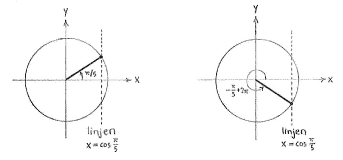Solution 4.3:1a
From Förberedande kurs i matematik 1
(Difference between revisions)
m (Robot: Automated text replacement (-[[Bild: +[[Image:)) |
m |
||
| (3 intermediate revisions not shown.) | |||
| Line 1: | Line 1: | ||
| - | + | If we draw the angle <math>\pi/5</math> on the unit circle, then it will have an ''x''-coordinate that is equal to <math>\cos \pi/5\,</math>. | |
| - | < | + | |
| - | + | [[Image:4_3_1_a.gif||center]] | |
| - | + | ||
| + | In the figures, we see also that the only other angle between <math>0</math> and <math>2\pi</math> which has the same cosine value, i.e. same ''x''-coordinate, is the angle <math>v=-\pi/5+2\pi = 9\pi/5</math> on the opposite side of the ''x''-axis. | ||
Current revision
If we draw the angle \displaystyle \pi/5 on the unit circle, then it will have an x-coordinate that is equal to \displaystyle \cos \pi/5\,.
In the figures, we see also that the only other angle between \displaystyle 0 and \displaystyle 2\pi which has the same cosine value, i.e. same x-coordinate, is the angle \displaystyle v=-\pi/5+2\pi = 9\pi/5 on the opposite side of the x-axis.

